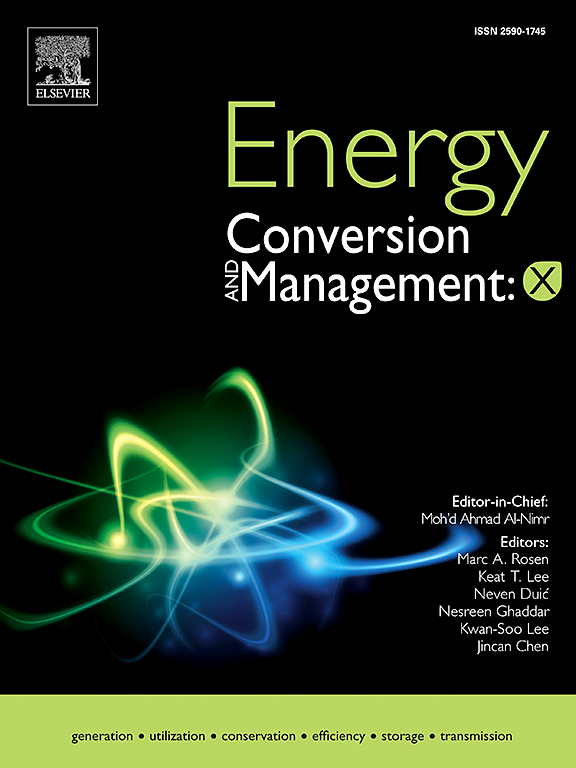Multi-objective topology optimization design of liquid-based cooling plate for 280 Ah prismatic energy storage battery thermal management
IF 10.9
1区 工程技术
Q1 ENERGY & FUELS
引用次数: 0
Abstract
Developing energy storage system based on lithium-ion batteries has become a promising route to mitigate the intermittency of renewable energies and improve their utilization efficiency. In this context, thermal management is needed to maintain battery temperature and thermal uniformity without consuming significant power. However, conventional cooling plates are usually built via trial-and-error methods, which suffer from trade-off problem between thermal performance and flow resistance. In this study, a multi-physics model incorporating electrochemical, hydrodynamic, and thermal fields is proposed for a battery pack. Meanwhile, a multi-objective topology optimization is introduced to freely evolve the distribution of fluid domain embedded into cold plate under specified constraint conditions. The multi-objective function is formulated using normalized additive weighting approach. Based on this, the mapping relations between design parameters (i.e., Reynold number and weighting coefficients) and performance of cold plate can be established via response surface method, and it is further optimized with a non-dominated sorting genetic algorithm. Results show that topological channel structure performs lower average temperature rise than traditional straight, serpentine, and hexagonal cold plates. When the mass flow rate ranges from 1 × 10-3 to 15 × 10-3 kg s−1, Nusselt number difference are varied from 1.33 to 5.90 compared to straight cold plate, which are improved by 15.6 to 42.2 %, respectively. This indicates that optimized cold plate achieves better heat exchange ability under the same inlet conditions. Besides, optimal design allows for excellent thermal uniformity without excessive pressure drop compared to serpentine cold plate.
280 Ah棱镜储能电池热管理液基冷却板多目标拓扑优化设计
开发基于锂离子电池的储能系统已成为缓解可再生能源间歇性、提高可再生能源利用效率的有效途径。在这种情况下,需要热管理来保持电池温度和热均匀性,同时又不消耗大量功率。然而,传统的冷却板通常是通过试错的方法来制造的,这种方法在热性能和流动阻力之间存在权衡问题。在这项研究中,提出了一个包含电化学、流体动力和热场的多物理场模型。同时,引入多目标拓扑优化方法,在给定约束条件下自由演化嵌入冷板的流体域分布。采用归一化加性加权法构造多目标函数。在此基础上,通过响应面法建立设计参数(即雷诺数和权重系数)与冷板性能之间的映射关系,并采用非支配排序遗传算法对其进行优化。结果表明,拓扑通道结构的平均温升低于传统的直线型、蛇形和六边形冷板。当质量流量为1 × 10-3 ~ 15 × 10-3 kg s−1时,与直冷板相比,努塞尔数差为1.33 ~ 5.90,分别提高了15.6% ~ 42.2%。这表明在相同进口条件下,优化后的冷板具有更好的换热能力。此外,与蛇形冷板相比,优化设计使其具有出色的热均匀性,而不会产生过大的压降。
本文章由计算机程序翻译,如有差异,请以英文原文为准。
求助全文
约1分钟内获得全文
求助全文
来源期刊

Energy Conversion and Management
工程技术-力学
CiteScore
19.00
自引率
11.50%
发文量
1304
审稿时长
17 days
期刊介绍:
The journal Energy Conversion and Management provides a forum for publishing original contributions and comprehensive technical review articles of interdisciplinary and original research on all important energy topics.
The topics considered include energy generation, utilization, conversion, storage, transmission, conservation, management and sustainability. These topics typically involve various types of energy such as mechanical, thermal, nuclear, chemical, electromagnetic, magnetic and electric. These energy types cover all known energy resources, including renewable resources (e.g., solar, bio, hydro, wind, geothermal and ocean energy), fossil fuels and nuclear resources.
 求助内容:
求助内容: 应助结果提醒方式:
应助结果提醒方式:


